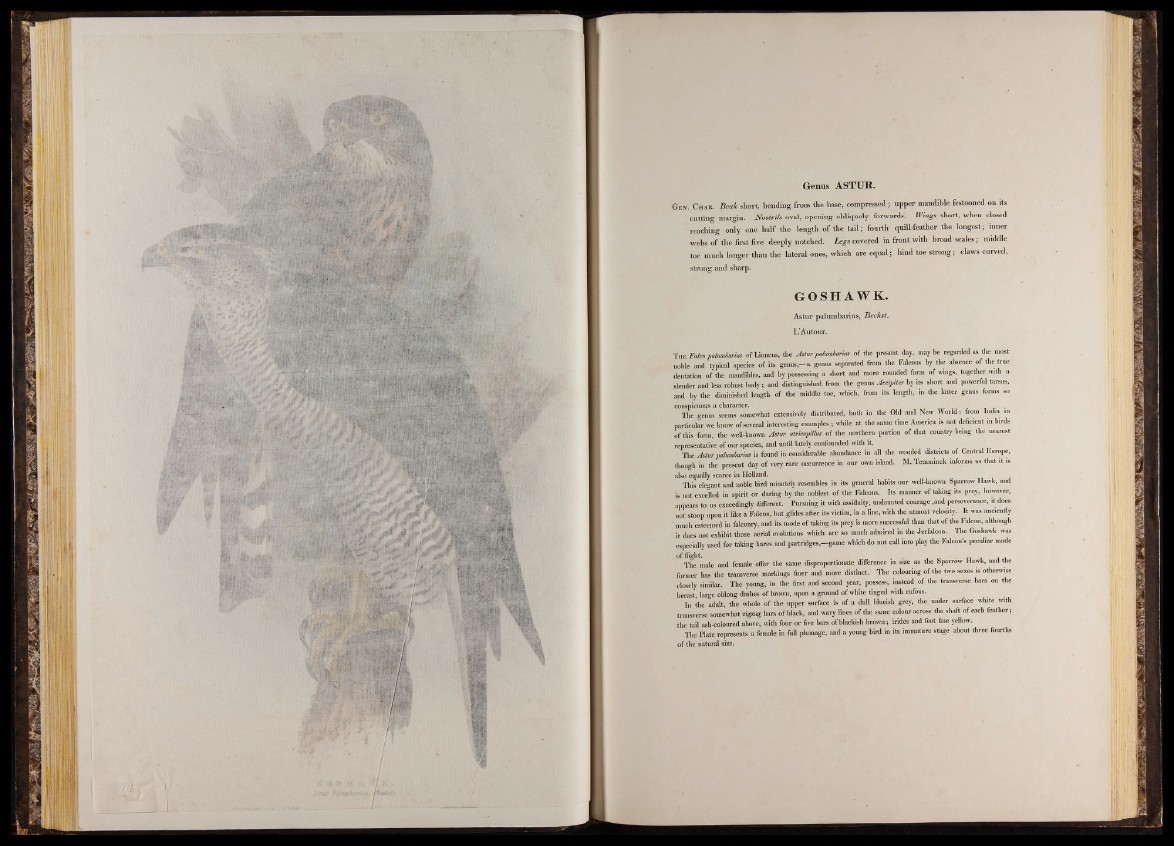
S Ä
S lS kW Ä M l !
WS
H r J0F j # '
w
'.-üii-;'“' § r g f.
W K ^ S m
p ik
ii;i‘?!il:':t5!
iwwiii;
Ü
Genus ASTUR.
Gen. Chab. Beale short, bending from the base, compressed ; upper mandible festooned on its
cutting margin. Nostrils oval, opening obliquely forwards'. Wings short, when closed
reaching only one half the length of the tail; fourth quiU-feather the longest; inner
webs of the first five deeply notched. Legs covered in front with broad scales; middle
toe much longer than the lateral ones, which are equal; hind toe strong; claws curved,
strong and sharp.
GOSHAWK.
Astur palumbarius, Bechst.
L’Autour.
T he Falco palumbarius o fL in n e u s, th e Astur palumbarius o f th e p re sen t day, may be re garded as th e most
noble and typical species o f its g e n o s , - a genus sepa rated from th e Falcons by th e absence o f th e tru e
d entation o f th e mandibles, and by possessing a sh o rt and m o re rounded form o f wings, to g e th e r with a
slen d er an d less robust b o d y ; an d distinguished from th e genus Accipiter by its sh o rt and powerful tarsus,
and by th e diminished length o f th e middle toe, which, from its len g th , in th e la tte r genus forms so
conspicuous a character. .
The genus seems somewhat extensively distributed, both in the Old and New World: from India m
particular we know of several interesting examples ; while at the same time America is not deficient in birds
of this form, the well-known Astur atricapiHus of the northern portion of that country being the nearest
representative of our species, and until lately confounded with it.
The Astur palumbarius is found in considerable abundance in all the wooded districts of Central Europe,
though in the present day of very rare occurrence in our own island. M. Temmmck informs us that it is
also equally scarce in Holland.
This elegant and noble bird minutely resembles in its general habits our well-known Sparrow Hawk, and
is not excelled in spirit or daring by the noblest of the Falcons. Its manner of taking its prey, however,
appears to us exceedingly different. Pursuing it with assiduity, undaunted courage ,and perseverance, it does
not stoop upon it like a Falcon, but glides after its victim, in a line, with the utmost velocity. It was anciently
much esteemed in falconry, and its mode of taking its prey is more successful than that of the Falcon, although
% does not exhibit those aerial evolutions which are so much admired in the Jerfalcon. The Goshawk was
especially used for taking hares and partridges,—game which do not call into play the Falcon’s peculiar mode
o f flight. .
The male and female offer the same disproportionate difference in size as the Sparrow Hawk, and the
former has the transverse markings finer and more distinct. The colouring of the two sexes is otherwise
closely similar. The young, in the first and second year, possess, instead of the transverse bars on the
hreast large oblong dashes of brown, upon a ground of white tinged with rufous.
In the adult, the whole of the upper surface is of a dull blueish grey, the under surface white with
transverse somewhat zigzag bars of black, and wavy lines of the same colour across the shaft of each feather j
the tail ash-coloured above, with four or five bars of blackish brown; irides and feet fine yellow.
The Plate represents a female in fell plumage, and a young bird in its immature stage about three fourths
of the natural size.